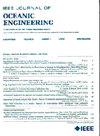盐水不完全火花放电电声过程建模--火花源
IF 3.8
2区 工程技术
Q1 ENGINEERING, CIVIL
引用次数: 0
摘要
众所周知,不完全火花放电会在盐水中产生振荡气泡和强烈冲击波,但人们对电声过程仍不甚了解。我们建立了一个现象学模型,并利用修订的等离子体电阻方程和简单的水电阻模型描述了电声过程。模拟结果与不同充电电压和电容条件下的实验结果非常吻合,包括负载电波形、气泡动力学和声波。此外,该模型还能成功计算等离子体通道中消耗的电能。模拟结果表明,能量效率随充电电压的增加而降低,但随充电电容的增加而提高。我们还发现,冲击波峰值和宽度的增加是放电能量的幂律函数。此外,冲击波峰值对充电电压更为敏感,而冲击波宽度受充电电容的影响更为明显。最后,所提出的模型再次证实,当充电电压增加时,水力效率和电声效率会降低,但随着电容的增加,水力效率和电声效率会提高。总之,该现象学模型是实用的,这项工作有助于开发应用于海洋地震勘探的不完全放电火花源。本文章由计算机程序翻译,如有差异,请以英文原文为准。
Modeling of the Electroacoustic Process of Incomplete Spark Discharge in Saline Water-Sparker Source
Incomplete spark discharge is known to generate oscillating bubbles and intense shockwaves in saline water, but the electroacoustic process is still not well understood. We develop a phenomenological model and describe the electroacoustic process, with a revised plasma resistance equation and a simple water resistance model. The simulation results agree well with experimental results under different charging voltages and capacitances, including the load electrical waveforms, bubble dynamics, and acoustic waves. Furthermore, the model can successfully calculate the electrical energy consumed in the plasma channel. The simulation results indicate that the energy efficiency decreases with increasing charging voltage, but increases with the increase of the charging capacitance. We also found that the shockwave peak and width increase as power-law functions of the discharge energy. In addition, the shockwave peak is more sensitive to the charging voltage, whereas the shockwave width is influenced by the charging capacitance more obviously. Finally, the proposed model confirms again that hydraulic efficiency and electroacoustic efficiency decrease when the charging voltage increases, but they increase with increasing capacitance. Overall, the phenomenological model is practical and this work helps in developing incomplete-discharge sparker sources applied in oceanic seismic explorations.
求助全文
通过发布文献求助,成功后即可免费获取论文全文。
去求助
来源期刊

IEEE Journal of Oceanic Engineering
工程技术-工程:大洋
CiteScore
9.60
自引率
12.20%
发文量
86
审稿时长
12 months
期刊介绍:
The IEEE Journal of Oceanic Engineering (ISSN 0364-9059) is the online-only quarterly publication of the IEEE Oceanic Engineering Society (IEEE OES). The scope of the Journal is the field of interest of the IEEE OES, which encompasses all aspects of science, engineering, and technology that address research, development, and operations pertaining to all bodies of water. This includes the creation of new capabilities and technologies from concept design through prototypes, testing, and operational systems to sense, explore, understand, develop, use, and responsibly manage natural resources.
 求助内容:
求助内容: 应助结果提醒方式:
应助结果提醒方式:


